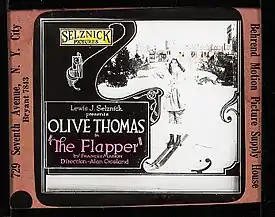The Flapper
The Flapper is a 1920 American silent comedy film starring Olive Thomas. Directed by Alan Crosland, the film was the first in the United States to portray the "flapper" lifestyle, which became a cultural craze or fad in the 1920s.
| The Flapper | |
|---|---|
 Glass slide for the film | |
| Directed by | Alan Crosland |
| Produced by | Myron Selznick |
| Screenplay by | Frances Marion |
| Story by | Frances Marion |
| Starring | Olive Thomas Warren Cook |
| Cinematography | John W. Brown |
Production company | |
| Distributed by | Select Pictures |
Release date |
|
Running time | 88 minutes |
| Country | United States |
| Language | Silent (English intertitles) |
Plot
Sixteen-year-old Genevieve 'Ginger' King (Thomas) is living in a very wealthy family in the boring town of Orange Springs, Florida with her younger siblings, where her unchaperoned decision to drink a soda with a young male is considered scandalous. Because of her questionable behavior and yearning for a more excitable life, Ginger's father decides to send her to a boarding school in Lake Placid, New York. Mrs. Paddles' School for Young Ladies is administered by the strict disciplinarian, Mrs. Paddles (Marcia Harris).
_-_1.jpg.webp)
Despite the strictness there, the girls have fun getting into flapper-lifestyle trouble including flirting. Richard Channing (William P. Carleton), an older man, rides past the seminary every day, prompting romantic fantasies among the schoolgirls. When Ginger connives a sleigh ride with Channing, she lies to him about her age, saying she is "about twenty". Ginger is quickly charmed and becomes enamored with him. Ginger soon gets into trouble with the headmistress by sneaking out to the local country club where Channing is having a party. One of her schoolmates, Hortense (Katherine Johnston), who is described as “a moth among the butterfies”, informs on her. Hortense’s actual motive for doing this is to get the headmistress out of the way so she can rob the school's safe and flee with her crooked boyfriend Thomas Morran (Arthur Housman).[2] Acting on a vaguely worded note she receives, Ginger—while traveling home from school—goes to a hotel in New York City where Hortense and Thomas are staying. They force her to take some suitcases for safekeeping, cases that contain stolen valuables, including fancy clothes and jewelry.
Knowing that Channing has gone to Orange Springs on a yachting trip, Ginger decides to use the clothes and jewels to present herself as a more-mature, well-dressed “woman of experience” when she returns home.[2] Her plan backfires, and her father believes she is lying when she says it is all a joke. Detectives then show up wanting to know why she has stolen loot; and both her young admirer Bill and Channing think she has really become a wicked woman. Hortense and her crooked boyfriend now turn up in Orange Springs to reclaim their illgotten loot. Their subsequent capture by the police clears Ginger's name and restores her reputation.
The events in the lives of Ginger King and another character are presented as incidents in a (non-fiction) newsreel at the end of the movie.
Cast
- Olive Thomas as Ginger King
- Warren Cook as Senator King
- Theodore Westman, Jr. as Bill Forbes
- Katherine Johnston as Hortense
- Arthur Housman as Tom Morran
- Louise Lindroth as Elmina Buttons
- Charles Craig as Reverend Cushil
- William P. Carleton as Richard Channing
- Marcia Harris as Mrs. Paddles
- Bobby Connelly as King, Jr.
- Athole Shearer as Extra (uncredited)
- Norma Shearer as Schoolgirl (uncredited)
Production notes
- Frances Marion wrote the screenplay, which is credited with popularizing the slang term “flapper” throughout the United States in the 1920s.[3]
- Olive Thomas appeared in only two films after The Flapper. She died in Paris in September 1920.[4]
Reception
The Film Daily gave it an overall positive review on May 23, 1920, praising the acting of Olive Thomas. Its main criticism was regarding the editing and the conclusion of the film, writing that the story was "cleverly written with many amusing situations, but latter reels should be compressed".[5]
Public domain and home-media release
References and notes
- "Current Releases". The Film Daily. May 30, 1920. Retrieved May 10, 2020.
- Quotation is transcription from one of the intertitles in The Flapper. “Bill Sprague Collection -THE FLAPPER-Olive Thomas-PUBLIC DOMAIN”, Internet Archive, San Francisco, California. Retrieved August 27, 2018.
- Boyer Sagert, Kelly (2010). Flappers: A Guide to an American Subculture. ABC-CLIO. p. 89. ISBN 978-0-313-37690-0.
- Lowe, Denise (2005). An Encyclopedic Dictionary of Women in Early American Films, 1895-1930: 1895-1930. Haworth Press. pp. 526. ISBN 0-7890-1843-8.
- "Wonderful Comedy Most Of The Way But Has Weak Finish". The Film Daily. May 23, 1920. Retrieved May 10, 2020.
- “The Flapper, 1920”, Public Domain Movies—Feature Films in the Public Domain. Retrieved August 27, 2018.
- Giddins, Gary (May 17, 2005). "Rediscovering Maurice Elvey's Masterpiece". nysun.com. Retrieved November 20, 2012.
External links
| Wikimedia Commons has media related to The Flapper. |
- The Flapper at IMDb
- The Flapper is available for free download at the Internet Archive
- The Flapper at AllMovie
- The Flapper at Rotten Tomatoes
- Variety 1920 Review
